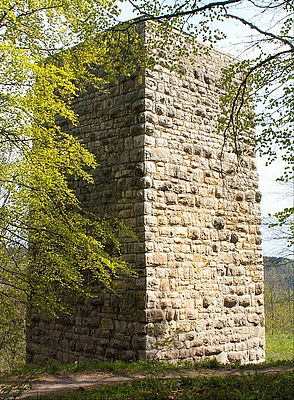Schalksburg (Württemberg)
| Schalksburg | ||
|---|---|---|
|
Lookout tower on the site of the former Schalksburg |
||
| Alternative name (s): | Schaltzburg, Schalksberg | |
| Creation time : | 1100 | |
| Castle type : | Hilltop castle | |
| Conservation status: | ruin | |
| Construction: | Small cuboid, cuboid and hump cuboid masonry | |
| Place: | To run | |
| Geographical location | 48 ° 14 '4 " N , 8 ° 55' 12" E | |
| Height: | 910 m above sea level NHN | |
|
|
||
The Schalksburg , formerly also called Schaltzburg or Schalksberg , is a former hilltop castle , the ruins of which are located around six kilometers southeast of Balingen between the Albstadt districts of Burgfelden and Laufen an der Eyach . The Schalksburg is one of the largest castles in the Swabian Alb in terms of area.
Geographical location
The castle is located in the district of Laufen at an altitude of 910 m above sea level. NHN on the very tip of the Steinberg and a 20-minute walk southwest of Burgfelden, which is one of the highest municipalities in the Swabian Alb . Burgfelden derives its name from the Schalksburg. The town's coat of arms shows the symbolized castle as the dividing line, the shield colors show the black and white of the lords of Zollern.
history
The Schalksburg belonged to the Counts of Veringen until 1262 . In 1266 it was already owned by the Counts of Zollern and was then temporarily the seat of the Zollern-Schalksburg branch of the noble family named after it .
The first traces of settlement date from the Bronze and Latène Ages . At the Schalksburg, fragments from the Middle Bronze Age were found, with finds also from the Urnfield Age (late Bronze Age), the Hallstatt and Latène Age ( Iron Age ) and the Roman Age .
In the St. Michael's Church in Burgfelden found Romanesque frescoes from the 11th century. Burgfelden was first mentioned as Burchveld in 1064 . The first foundation walls and grave finds of St. Michael date from the late Merovingian period at the beginning of the 8th century. The village probably emerged from an ancient noble residence from the 7th century. The castle complex dates from the year 1100 and the first notifications of the Schalksburg can only be found by Count Friedrich V in 1266. However, fortifications were probably already in place at the site of the castle complex before 900.
After the division of the Hohenzollern Line in 1288, Frederick I, called the Boy († 1308), took his seat at the castle. In the 14th century, the Schalksburg was called a palace and, with an area of three hectares, represented a mighty complex.
In 1403 the rule of Schalksburg with the city of Balingen and 17 other localities, u. a. Onstmettingen , by Count Friedrich V von Zollern-Schalksburg after the death of his only son for 28,000 guilders to Count Eberhard III. († 1417) sold by Württemberg . The line of the Counts of Zollern-Schalksburg expired with the death of Friedrich V von Zollern-Schalksburg in 1408.
This transfer of rule to the Württemberg people is handed down in the saga of the Hirschgulden , which was recorded by Gustav Schwab and Wilhelm Hauff - according to the legend, only one gulden was paid here.
In 1464 the Schalksburg was destroyed by Count Jos Niklas I von Zollern during a feud with Hans von Rechberg on behalf of Württemberg. In 1465 it was rebuilt. During the German Peasants' War (1524–1526), Pfeffinger and Dürrwanger farmers besieged and captured the Schalksburg. In 1557 the castle was demolished because it was in disrepair, in 1624 it is only called the castle stables .
1957-1960 a lookout tower was built on the remains of the medieval keep with the help of helicopters of the American army . From the edge of the Albtrauf there is a wonderful view over the Alb foreland, the Eyach Valley and the Balingen Mountains .
description
Of the former isosceles castle complex with the "Old Castle" in the western part, there are still up to 3.50 meter high wall remains of the old keep in the southern part of the original structure, which is 7.7 by 7.5 meters thick of 2.75 meters.
Varia
In his novella Das Wirtshaus im Spessart, Wilhelm Hauff lets the blacksmith tell about the origins of the Schalksburg in the saga of the Hirschgulden .
literature
- Günter Schmitt : Castles, palaces and ruins in the Zollernalb district . Published by the Zollernalbkreis district office, Jan Thorbecke Verlag, Ostfildern 2007, ISBN 978-3-7995-0186-6 , pp. 49–56.
- Christoph Bizer: Surface finds of castles in the Swabian Alb - A contribution to ceramic and castle research . Published by the regional council Stuttgart - State Office for Monument Preservation, Konrad Theiss Verlag, Stuttgart 2006, ISBN 3-8062-2038-7 , pp. 182-188.
- Günter Schmitt: Castle Guide Swabian Alb, Volume 5 - West Alb: Hiking and discovering between Reutlingen and Spaichingen . Biberacher Verlagsdruckerei, Biberach an der Riß 1993, ISBN 3-924489-65-3 , pp. 315-324.
Web links
- The Schalksburg saga (PDF file; 6.03 MB)
- Image of the observation tower ( Memento from October 11, 2016 in the Internet Archive )
- Reconstruction drawing by Wolfgang Braun
Individual evidence
- ↑ a b Entry on Schalksburg in the private database "Alle Burgen".
- ↑ State Institute for the Environment Baden-Württemberg (LUBW) ( information ) - data query object information
- ↑ Map services of the Federal Agency for Nature Conservation ( information )
- ↑ Hohenzollerische Heimat; 59th year, 2009, page 33 f.
- ↑ Heinz Bader: At the origin of the Eyach. Alt-Pfeffingen . Geiger-Verlag, Horb am Neckar 1992. ISBN 3-89264-722-4





